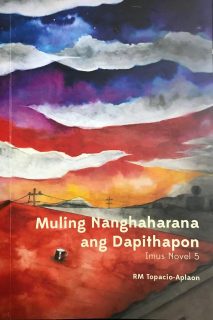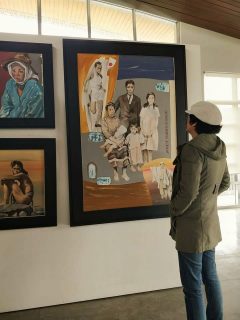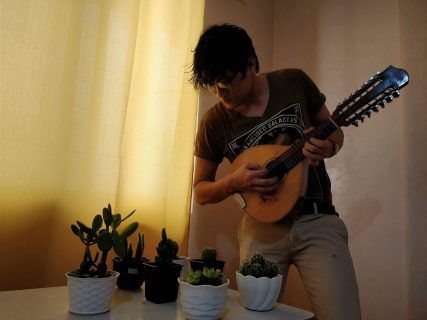By Caesar Vallejos, Eagle News Service

While people have yet to start browsing at least one of the many recommendations to read when you’re under 30 or 40, this 30-year old novelist who hails from Imus has not only read but already written a handful, only half of which being made published.
LA-based writer and filmmaker Brenden Gallagher said, “one of the hardest things a person can do is complete a great novel. There are a handful of gifted authors who were able to finish writing one before they were 30 years old.”
RM Topacio-Aplaon’s latest novel “Muling Nanghahara ang Dapithapon” (Dusk Serenades Again), the 5th in his Imus saga, is freshly published by the University of the Philippines (UP) Press.
The Imus septology
“It’s a septology. In essence, they can be read independently but they are metaphysically interconnected. I call it Imus Novels,” Topacio-Aplaon said.
However, he said that when he started writing the first book on Imus in 2006, he had no design to work on a septology. “I had no inkling that I would end up writing six more. I was just writing about my emotions, trying to comprehend what’s happening in and around Imus,” he declared.
The very moment that Topacio-Aplaon realized that he was born to be a novelist, he was very sure that he would write about his hometown.

“I know that there’s a lot of stories that need to be written specifically about the inner politics—the issues of rape, pre-mature sex, and even the agricultural aspect in which the landlords would grab lands from small people,” he said. Suicide is also one his novel’s central themes.
He said that in the septology, most of the central plots transpired in Imus but, in the latter novels, the setting would happen in Visayas and Mindanao. “Nonetheless, the metaphoric setting will always be Imus. The Imus Novels can be physical, tangible, or even metaphysical and emotional, it’s all-encompassing in that way,” he described.
However, he was quick to debunk that he was neither writing about Imus to promote Imus nor writing to be socially relevant.
“I write because art is inherent, natural. Nasa buto, kalamnan, pagkatao, espiritu, at kaluluwa ko ang aking bayan at ang pagsusulat,” he said.
Not a love story
One reporter called his latest work a love story. Topacio-Aplaon said, “I hated it but at the end of the day, once a novel gets published, it’s open to whatever branding that people and readers would like it to be.”
Muling Nanghaharana ang Dapithapon is “a humble, open letter to beginning writers, however abstract, absurd, or obscure the notion might be. It is also for people who are “dreaming to becoming artists – writers, dancers, any art form.”
Topacio-Aplaon said that it is the shortest of the Imus novels at 150 pages. The last of the series is approximately 700 pages.
“While it is fiction and will always be one, it is the most autobiographical of all my novels,” he described.
He wrote it at the time he thought that his career as a novelist was over. “When I was younger, my amateurish notion of being a writer is having your name mentioned with the canonical works of the greats,” he recalled.
“I realized that I was already a writer long before I thought that I was one. It happened the moment I began to give and sacrifice everything to and for the craft,” he said.
Just when he came to the realization that writing is not about getting published, it was ironic that it was the same day that UP Press emailed him for his work, ‘Lila ang Kulay ng Pamamaalam,’ the third and the central work in the saga, to be printed.
He said, “I will say it in Filipino, because it is beautiful: sa mismong araw na sinabi ko na magiging manunulat ako, na niyakap ko at ipinagpalit ang lahat para sa pagsusulat, ay manunulat na pala ako.”
And what he thought was his novel writing’s ‘end’ was obviously another beginning.
The most beautiful selfish thing in the world
While Topacio-Aplaon is into serious writing, he said that “the funny thing is that I personally don’t think of readers—I think only of myself each time I write. Writing is the most beautiful selfish thing in this world.”

“I am channeling my inner self when I write. It is like urinating and defecating. To me, it is part of my senses, my life, it is part of my everything,” he said.
I think that it is the reason why all my attempts at self-publishing failed because I can never market myself. That’s the job of the publishers and the agents,” he unapologetically said.
He shared he has never been censored and dictated by his publisher in terms of structure, sound, tone and the potential market of his novels.
Comparing himself with musicians or theater performers who yearn for the audience applause, he explains “I would never really think of reader’s reactions.” He admits, however, that during talks and book signing events, he feels happy when young people would approach him to say that his book somewhat, in one way or the other, changed their lives.
“I feel happy and delighted that somehow a novel that I write for myself changed at least a portion of a young writer’s life, even non-writers,” he said.
Truthful but suicidal
All seven novels of Topacio-Aplaon deal with the theme about death and life. Some call him a hyper-realist.
“I think suicide is everywhere in my work, ubiquitous and omnipresent even. I write because it is reality, it is part of life. When you write you try to grasp everything—reality and lies and everything in between.”
“I was, and I think I still am suicidal in nature. I tried countless times but a Divine Intervention would always happen and I’m still fortunate to live. There’s also people around me who helped me understand everything.”
If you have tendencies, he said, “It’s a daily battle, and the moments of solitude or even being alone in your home, thoughts are the battlefield. You fight, and, always, I would say, in moments of doubt and fear, choose life.” ”
While he battles with the dark side of his character, he is very passionate about honesty in the craft.
“The hardest thing about embracing an art form in general is not being truthful to your craft,” he said with conviction.
Without honesty, he said, that “it is hard for the artist to conduit his spirit to his chosen craft.” He said that it is the artist himself who should believe in his work more than anyone else in this world.
“I can lie to the world, but not with my craft,” he said. Topacio-Aplaon writes his novels in longhand, the traditional way.
The writer’s dreams
“I am not a vicarious writer, but a research- heavy and immensely immersive novelist,” he said. “I would not write about a policeman or a politician without meeting one,” he narrated. For his English work, At Night we are Dancers, Topacio-Aplaon interviewed and lived with real-life criminals.

His dream is “to quit the corporate world, prostituting my pen,” and just “write and write until I die.” However, he noted that “if there are financial rewards to it, then surely it will help a lot of writers and people.”
According to the novelist, the Philippines is not a reading country but a music nation.
“I want to see more people reading not only foreign works but also Filipino works. I dream of people reading not just my works but the lots of fantastic novelists whom I idolize, and there’s lots of Filipino novelists,” he said.
Topacio-Aplaon also has a short story and poem collections in English and currently fixing “El árbol de la alegría” that is written in English and Filipino but is planned to be translated in Spanish. “I am a mediocre writer in Spanish,” he humbly confesses.
After his Imus saga, Topacio-Aplaon has begun working on The Southern Quarter, four short novellas set in Mindanao and Visayas.
Asked if there were views that he wanted to change in his previous works, the young novelist said, it would be his “views on women” because he said “he was still immature when he was writing the first ones.”
However, he quickly noted that “there is no conscious effort on my end to change my views on anything because I think that my novels in some ways are recorder of my past sentiments.”
Let history judge me,” he stressed. “I consider myself a blossoming feminist,” he added.
Also asked to choose between a book and a woman, he quipped, “they are life, you can’t separate them.”







